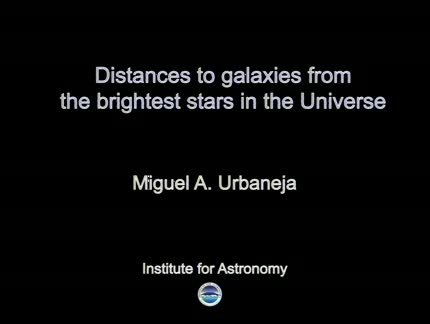Found 3 talks width keyword supergiants

Abstract
Exciting things may have happened sometimes to the stars we see in the sky today. For example, Betelgeuse, also known as Alpha-Ori, an M-type red supergiant, the 10th brightest sky in the sky (usually), may well have been a binary star in the past. Its rapid rotation, peculiarly large Galactic velocity, and unusual chemical abundances all point to it being kicked out from the birth environment and merging as a binary star. By comparing a Monte-Carlo stellar cluster population model with the observed populations of Galactic O- and B- type stars (progenitors of red supergiants), I will show that the story of Betelgeuse is not at all uncommon. In distant galaxies, closely related scenarios may give rise to peculiar core-collapse supernovae. I will conclude by briefly discussing how the diversity of such binary and triple stellar evolution histories reflects in the variety of the currently discovered core-collapse supernovae.

Abstract
The determination of chemical composition and distances of galaxies is crucial for constraining the theory of galaxy formation and evolution in a dark energy and cold dark matter dominated universe. However, the standard technique using HII regions to determine the metallicity of star forming galaxies, nearby and at high redshift, is subject to large systematic uncertainties that are poorly understood and the determinination of accurate distances using Cepheids suffers from uncertainties caused by the metallicity dependence of the period luminosity relationship and extinction and crowding corrections. Multi-object spectroscopy of blue and red supergiant stars - the brightest stars in the universe at visual and NIR wavelengths - provides an attractive alternative. I will present results accumulated over recent years for galaxies in the Local Group and beyond out to a distance of 8 Mpc and will discuss the potential of future work with TMT and E-ELT. Combining the photon collecting power of these next generation telescopes with Adaptive Optics we will be able to study individual supergiant stars in galaxies as distant as the Coma cluster. With spectroscopy of the integrated light of young very massive Star Super Clusters and simple population synthesis techniques we can reach out ten times further.

Abstract
Measuring distances to galaxies and determining their chemical compositions are two fundamental activities in modern extragalactic astronomy, in that they help characterizing the physical properties of their constituents and their evolutionary status. Ultimately, these measurements lead to stronger constraints on the cosmological parameters of an expanding universe and the history of cosmic chemical enrichment. Both these questions can be tackled afresh with the quantitative analysis of the absorption line spectra of individual massive and luminous, young B- and A-type supergiant stars. A spectroscopic distance determination method, the FGLR, can yield accurate distances up to several Mpc, extending to a local volume where the results can be compared with those obtained from Cepheids and other distance indicators. Moreover, and this being a unique advantage of the FGLR, reddening values and metallicities are simultaneously determined for each individual stellar target. These stellar metallicities are very accurate and can be used to constrain the formation and evolution of galaxies and to assess and overcome the systematic uncertainties of H II region strong-line abundances through a galaxy-by-galaxy comparison. Moreover, stellar spectroscopy provides fundamental complementary abundance information for star forming galaxies on additional atomic species such as iron-group elements. I will present recent results of our on-going efforts to study individual blue supergiant stars in galaxies within and beyond the Local Group based on medium and low resolution optical spectra collected with ESO VLT and the Keck telescopes. The promising perspectives of future work, based on the giant ground-based telescopes of the next generation (E-ELT, TMT) are also discussed.
« Newer Older »
Upcoming talks
- Runaway O and Be stars found using Gaia DR3, new stellar bow shocks and search for binariesMar Carretero CastrilloTuesday April 30, 2024 - 12:30 GMT+1 (Aula)
- Detecting GWs in the muHz: natural and artificial satellites as GW detectorsProf. Diego BlasThursday May 2, 2024 - 10:30 GMT+1 (Aula)









